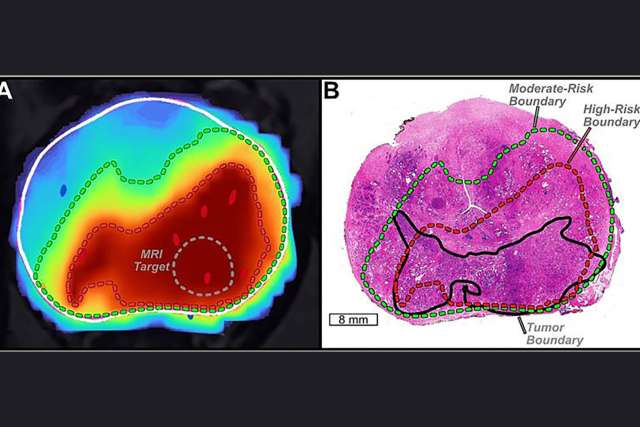If a person arrives at the emergency room with chest pain, labored breathing and nausea, the physician’s challenge is to determine the cause. Symptoms like these can be associated with a range of conditions, including a heart attack.
A blood test can help narrow the diagnosis – in this case, measuring levels of troponin, a heart muscle protein, which can indicate cardiac damage. The patient’s blood is sent to the clinical lab in the basement of the Ronald Reagan UCLA Medical Center. Within 20-45 minutes, the lab delivers results to the doctor.
“Decision-making in medicine is difficult. Our tests are the critical pieces of data that allow a clinician to treat our patients as fast as possible,” said Omai Garner, PhD, vice chair of clinical laboratory affairs and professor in the department of pathology and laboratory medicine at the David Geffen School of Medicine at UCLA.
Dr. Garner helps to oversee the nearly 12,600-square-foot clinical laboratory, which operates around the clock and processes every tube of blood drawn in the main hospital, emergency room and clinics in the adjacent UCLA Medical Plaza.

Fully automated technology performs about 20 million blood tests a year. A recent major upgrade not only expanded test volume by 10% but the types of testing possible.
The state-of-the-art automation also frees up clinical laboratory scientists (CLS), also known as medical laboratory scientists, to ensure quality control and focus on more specialized testing. Automation is also crucial given the nationwide shortage of CLS.
Hidden away in the bowels of the hospital, laboratory staff never encounter patients but only “the precious commodity that we know is directly related to their health care,” said Dr. Garner.
“It's not just tubes of blood. There is a very personal responsibility that we take.”
Journey of a sample
The lab is in a continuous race to keep up the pace of testing. The starting line is the chute that delivers vials of blood.
The chute is connected to a 1.7-mile pneumatic tube system that winds its way through every corridor and floor of the hospital, a two-way highway with its own control room.
After a blood draw, the blood is carefully packaged and sent down the highway, landing with a gentle thump in the laboratory.
A laboratory technician removes the packaging and delivers the blood to the automated system.
The tube has a barcode with instructions on what tests to run. Some require that the blood is separated into its components, so the machine will spin it through a centrifuge.
If multiple tests are required, the blood is divided into separate tubes. Everything is labeled and trackable.

Some of the more routine tests are a comprehensive metabolic panel (CMP) which measures 14 substances, including glucose, calcium and total protein.
A complete blood count (CBC) is a test run on whole blood that measures the number and size of different blood cells.
Because the hospital is a quaternary care center for complex and rare conditions, the clinical laboratory also performs more specializing testing. These include coagulation testing that can determine bleeding or clotting risks that may lead to a stroke.
The lab also has an entire suite of tests for hepatitis, to help pinpoint the cause for patients with liver failure.
According to Dr. Garner, errors are extremely rare because of automation and quality control by the CLS. Automation is also key to maintaining a rapid pace.
It still takes a certain amount of time to complete a test, but the machines enable scale – from 10 to 100 times the number of tests performed by a human lab scientist.
Central to efficiency is “The Line.”
Once tubes are labeled and processed, they end up on a conveyor belt that stretches 78 feet. It’s one of the longest in a Southern California hospital system and reflects the volume of testing in the lab.
The Line shuttles tubes to stations for the most common testing, eliminating the need for CLS to manually process and move tubes – a seemingly mundane action that can add up to hours lost.

“I shouldn't have the CLS walking from here all the way over there,” said Dr. Garner. “Because if they do it 30 times a day, and it takes 30 seconds, it just adds up to them not being able to do what we really need them to do, which is the specialized testing.”
Once testing is complete, results are available to clinicians in the hospital’s electronic records system.
The Line sends the blood to refrigerated storage where it will be available if it needs to be tested again.
Patient impact
With millions of tests running, Dr. Garner said clinical stories help keep staff engaged “so they understand the impact for the patients who are just upstairs.”
The lab’s chief of clinical chemistry, Lu Song, PhD, recalled the case of a 74-year-old woman who began to feel sick while on vacation in Europe and became progressively worse when she returned home to Los Angeles.
“It's like being a detective. We work with the doctor to investigate the problem and find an appropriate test method for the patient,” said Dr. Song, a professor in the department of pathology and laboratory medicine at the medical school.
A blood test revealed an alarming result. The woman’s creatinine, a marker for kidney function, was nearly 27 times the normal range. The patient was admitted into the hospital for acute renal failure and treated with dialysis.
A day later, the lab performed additional tests that helped physicians diagnose the woman with light chain myeloma, a type of blood cancer.
The woman’s case was complex and CLS oversaw her testing to deliver results quickly to her physicians.
Future upgrades
CLS were also integral while the lab was upgraded, ensuring that operations ran smoothly while machines and configurations were improved.
Upgrading the lab’s automation was a year-long project that Dr. Garner likened to “engineering Legos.” Equipment was custom fitted to ensure smooth continuity between machines.
Engineers even had to account for a natural slope under the hospital building to make sure The Line was level.
Dr. Garner estimates about seven years until the next upgrade as faster equipment is made available, as well as new ways of testing and better chemistry analyzers.
Staying on top of technology, now and in the future, is key to the laboratory, a 24/7 system that serves patients and providers with rapid and accurate testing.
“This upgrade really took us to that next step,” said Dr. Garner.
“The clinical lab is one of the more critical pieces of patient care and I think it's one of the under-recognized reasons why we are one of the best hospitals in the country.”





